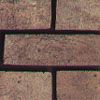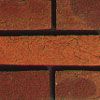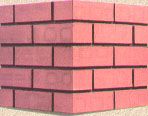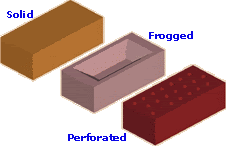Types of bricksThere are literally thousands of different bricks, but they can be broken down into a handful of basic types. The vast majority are made from clay and are kiln-fired.Facing BricksQuality, durable bricks with an attractive appearance for external use above ground. | |||
| | WirecutThe clay is continuously extruded to a required size and shape and then cut into individual bricks by means of a wire, much like a cheese is cut by cheesewire. Thousands of variations in colour and texture. Usually the cheapest facings available as the manufacturing process is highly automated. | ||
| | |||
HandmadeUsually made on a bench, in a mould, much as described above for a stock brick. Because the clay isn't firmly compacted by machine, each brick normally has distinctive creasing known as a 'smile'. Very desirable, and the most expensive of the facings, but well worth it on prestige jobs. |  | ||
FlettonAlso known as 'London Bricks'. A unique facing brick manufactured from the Lower Oxford clay found only in SE England. This clay contains coal traces, which burn during firing, reducing the amount of fuel needed for the kiln, which not only keeps down costs but also produces some interesting effects in the bricks themselves.  |  | ||
Commons A cheap 'fill' brick, designed to be utilitarian rather than attractive. Having said that, some have a charm of their own and are perfectly fine for smaller jobs. |
Engineering  The workhorses of the brick family. Tough, strong, hard-wearing but not usually very pretty. They have excellent resistance to frost and to water, making them ideal for groundworks, sewer works and retaining walls. You pay for the performance. |
Concrete or Calcium Silicate  Popular in areas where good brick-making clay is scarce. Some are, quite frankly, bloody awful, but others may be split-faced or have a pitched face to give an impression of being something other than boring concrete. Cheap and cheerful sums them up. |
Reclaimed | |
| Salvaged bricks. Bricks rescued from old buildings and cleaned up, of a fashion. You really have to know what you're looking for to make sure you get decent quality rather than any old dross, so buy through a reputable merchant. Their charm is undeniable, when laid by a good brickie, but there can be a high level of wastage. Many will be the old Imperial sizes (2 5/8" or 3")which are incompatible with the modern metric bricks (65mm). Don't be fooled into thinking that because they have been rescued from some old doss house that they will be cheap - cleaning them up and sorting them is a labour intensive task and they can cost twice the price of a quality facing or a 'reproduction' reclaimed. Laying Bricks Coping stones | |








No comments:
Post a Comment